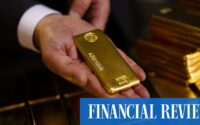Here’s what the gold-silver price ratio tells us about silver
By Myra P. Saefong
Silver has underperformed gold this year, providing an opportunity for investors betting on growth in demand for the white metal, as analysts warn of potential challenges to mining supplies.
It would “not surprise us” if silver outperformed from their current levels, with industrial demand for the metal “expected to grow as the energy transition picks up steam over the coming decades,” said Taylor McKenna, analyst at Kopernik Global Investors. He points out that silver is one of the best conductors of electricity and is instrumental in solar energy and electric vehicle batteries.
And if silver prices don’t move higher, supply may also decline as “mines shut down and incentives are not there for new ones,” he said.
On Tuesday, the most-active December silver contract settled at $23.40 an ounce on Comex, after posting a loss of nearly 5.7% last week, the largest weekly percentage decline since the week ended June 23, according to Dow Jones Market Data. Year to date, silver futures have lost nearly 2.7%.
“Silver provides a good entry point here,” said Keith Weiner, chief executive officer at Monetary Metals in Scottsdale, Ariz.
He believes the intermediate and long-term trend for gold and silver is “upward as the dollar continues to lose its base.” This can be “punctuated by short-term news cycles and crises.”
As of Wednesday, however, the ICE U.S. Dollar Index DXY has gained more than 1% this year.
The latest reading on the U.S. consumer price index revealed a 0.6% increase in August, the largest rise in 14 months, while the so-called core inflation rose, excluding energy and food prices, rose by a smaller 0.3% in August. The annual rate of inflation rose to 3.7% from 3.2% in July.
The “hotter-than-expected “inflation data supports the argument around the Federal Reserve “still having some headroom to hike [interest rates] one more time in 2023,” said Lukman Otunuga, manager, market analysis at FXTM.
That development is likely to support the dollar, so “gold may be exposed to more losses this week,” he told MarketWatch.
Gold-silver ratio
So far this year, silver has declined, but gold has seen notable gains.
Gold futures’ December contract ended Tuesday at $1,935.10 an ounce, trading nearly 6% higher year to date.
“Silver tends to be more volatile than gold, while still maintaining a close correlation of price movement over the long term,” Alex Gordon, director at ETF Managers Group, told MarketWatch.
Historically, the gold-silver ratio sits between 50 and 60, but currently stands at more than 80, he said. That means it would take more than 80 ounces of silver to buy one ounce of gold. The high number points to “silver being undervalued to gold on a relative basis,” said Gordon.
Kopernik’s McKenna points out that gold is 18 times more rare than silver, which is much lower than the current 88 to 1 ratio assumes. Given that, “it would not surprise us if silver outperformed at least until it reached its long-term 50 to 1 ration average, he said.
Mining challenges
Silver supply fundamentals also point to potentially higher prices in the future, said McKenna.
“Mining is a tough business, but evidence suggests it is only getting more challenging worldwide, especially in areas where silver is most abundant,” he said. Increased pressure and regulation around environmental, social, and governance mandates “disincentivize investment and could significantly impact supply in the future.”
Mexico, for example, is the largest producer of silver, he said, but there’s a risk of nationalization recently, as the government nationalized lithium production and adopted higher taxes across the mining sector.
In Peru, which is also among the world’s largest silver producers, there have been attempts to adopt policies to increase taxes on mining companies, leading many companies to postpone investment decisions, said McKenna.
He said Kopernik is “excited” about its investments in mining companies because most are trading below liquidation value, which he describes as valuation assuming current metal prices.
Those companies include Equinox Gold Corp. (EQX.T), said McKenna, noting that the company has built a portfolio of producing gold mines mainly through disciplined acquisitions.
Equinox Gold trades below liquidation value, assuming current metal prices, and has “tremendous optionality to higher prices,” especially as its new mine, Greenstone in Ontario, Canada, is completed over the next 12 months, he said.
Kopernik counts mining companies that are still shunned by the market as among its investments, said McKenna. “We see upside to our investments if gold and silver prices stay at current prices, and tremendous upside should they increase.”
-Myra P. Saefong
This content was created by MarketWatch, which is operated by Dow Jones & Co. MarketWatch is published independently from Dow Jones Newswires and The Wall Street Journal.
(END) Dow Jones Newswires
09-13-23 1225ET
Copyright (c) 2023 Dow Jones & Company, Inc.
[ad_2]
Source link


